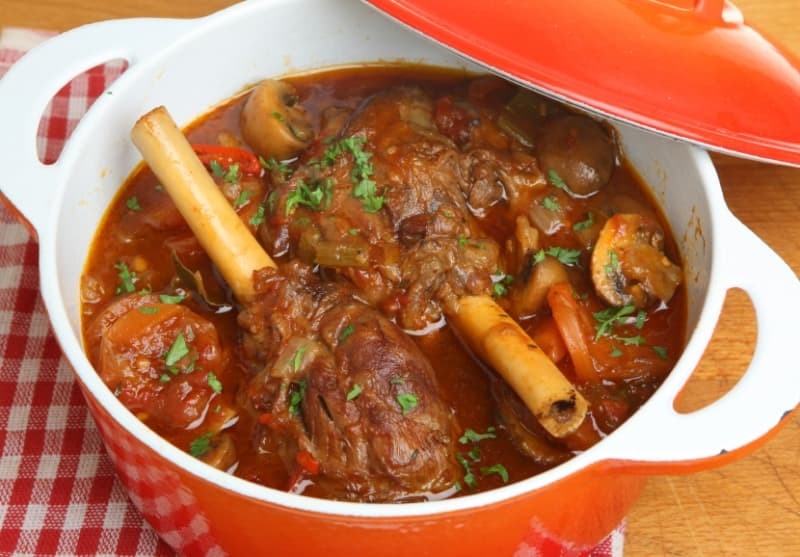
Beautiful veggies and gorgeous pearl barley give this stew heartiness, while the slow cooked lamb gives that classic melt-in-the-mouth tenderness.
Lamb meat has been a dining table staple as early as 8,000 BC, the earliest recorded time cattle were domesticated. It is famous in Europe, especially in Ireland, where lamb or mutton is used to make Irish stew, though it is less common in America, perhaps because of its higher price, a scarcity of lamb, or the fear of having tough, chewy meat for dinner as a result of undercooking it. The good news is that lamb consumption has increased in many Western countries, especially during the winter months when lamb serves a warming purpose for the body.
Warm meats, such as lamb or mutton, are typical and ideal in Traditional Chinese Medicine (TCM) since they protect our organs from the cold environment. Additionally, slow cooking choice cuts of lamb with root vegetables, fresh rosemary, chopped celery stalk, and pearl barley in red wine sauce, vegetable stock, or other cooking liquids, makes for the perfect winter casserole dish.
Health Benefits of Lamb Shank Stew
Lamb meat is a rich source of iron, protein and B vitamins. It's also packed with zinc, phosphorus, and selenium, which makes a pot of cooked lamb shank perfect for boosting immunity, building strong bones, and creating healthy blood cells. In addition to this, combining tender lamb shanks with all the vegetables you can use is key to achieving a scrumptious and healthy dish your whole family will enjoy.
In order to get a deeper flavour out of the dish, you should use as many herbs as you can get your hands on. Although fresh sprigs of rosemary are ideal, don't worry if you don't have any on hand. They can easily be substituted for bay leaves in combination with other herbs like oregano and thyme.
How to Cook Lamb Shank Stew
There are different ways of cooking lamb meat. You can either season lamb shanks and bake them or mix them with vegetables and cook them in beef broth or other braising liquids in a slow cooker or crock pot, allowing their flavours to infuse into the dish. Whatever your preference, this guide will ensure that you achieve a dish with a deliciously complex taste combined with tender meat.
If you're cooking with pearl barley, remember to soak the barley for 8 hours prior to cooking as this will aid its digestion and also increase the bioavailability of its nutrients. If you like, you could also add one tin of chopped tomatoes when adding the stock.
This basic recipe for a leg of lamb serves 6 and will still fair well as a leftover provided that you store it in an airtight container. Just heat and enjoy the next day.
Ingredients
- 3 tbsp olive oil or ghee
- 2 medium or 3 small lamb shanks
- 1 carrot, diced
- 1 onion, diced
- 2 celery sticks, chopped
- 1/4 Jap pumpkin, diced
- 2 potatoes, peeled and diced
- 2 small rosemary stems, leaves removed
- 1 cup pearl barley, rinsed, soaked overnight (or for 8-12 hours)
- Approx. 1 L vegetable/chicken/beef stock
- 1 cup of wine (optional)
- Salt & pepper to taste
- 1 cup frozen peas, defrosted
Instructions
- Heat two tablespoons of olive oil/ghee in a large soup pot on medium-low heat. Place the shanks in the pot and allow them to brown (about 5 minutes, turning every now and then with tongs to ensure even cooking).
- Remove the browned shanks from the pot, place on a plate and set aside.
- In the same pot, add a further tablespoon of oil /ghee, and then add the carrot, onion and celery to the pot and sauté for a few minutes. Next, add the pumpkin, potatoes, rosemary leaves and sauté for another minute.
- Add the shanks, pearl barley, wine (if using) and stock (enough to cover the contents), followed by a teaspoon of salt and black pepper. Bring to a gentle boil, then reduce to very low heat, cover the pot and allow to slow cook for 2-2.5 hours, stirring occasionally and ensuring adequate stock (keeping in mind that the pumpkin will collapse and thicken the stew).
- Turn off the heat. Remove the shanks with tongs and set aside on a plate to cool down.
- Once cooled, break away the meat from the bone into chunks using your fingers or a fork. Return the meat to the pot. Add the peas and serve.









